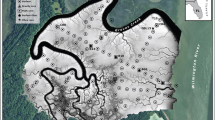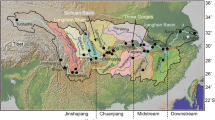Abstract
Purpose
This study uses sediment cores to quantify Holocene sedimentation rates in the Trinity River delta, Texas. An important question is whether modern fluvial sediment input from the Trinity River is adequate to sustain sedimentation in the delta, thereby combating subsidence and further wetland loss. Our objective was to quantify sedimentation rates within the delta in order to assess whether the delta is in- or out-of-phase with modern sediment delivery rates.
Materials and methods
Two core samples were retrieved from the subaerial Trinity River delta, an intricate system of anastomosing/bifurcating channels, levees, lakes, and interdistributary marshes covering an area of 126.1 km2. Detailed descriptions of sample characteristics were recorded, including wet and dry color, texture, moisture content, and plasticity. Bulk density and grain-size measurements were also conducted on the cores. Shell fragments from each sediment core were subjected to accelerator mass spectrometry 14C dating.
Results and discussion
Radiocarbon dating of shell fragments recovered from sediment cores (292–536 cm) ranged from 2.8 to 3.2 Ka. Mean sediment accumulation rates varied between 1.2 and 1.8 mm year–1 for two areas of the delta, consistent with previous research. The amount of sediment needed to cover the surface area of the modern Trinity River delta was calculated to obtain the approximate amount necessary for accretion rates from 0.25 to 3.0 mm year–1. Using the mean Holocene sediment accretion rate from this study (1.5 mm year–1) to cover 100% of the Trinity River delta, the amount of sediment needed per year was calculated to be 265,000 Mg year–1, which is 3.8 times the amount of sediment (i.e., 70,000 Mg year–1) currently delivered to the delta by the Trinity River. Modern fluvial sediment input from the Trinity River is thus inadequate to account for Holocene sedimentation rates in the delta.
Conclusions
Sediment accumulation rates of 1.2 and 1.8 mm year–1 were attained for two interdistributary marshes in the Trinity River delta by radiocarbon dating of shell fragments recovered from sediment cores. These accumulation rates are well within the ranges established in previous studies. However, modern fluvial sediment input from the Trinity River to the delta is occurring at a rate of approximately 0.4 mm year–1, which is insufficient to combat subsidence and wetland loss and keep pace with future sea level rise.









Similar content being viewed by others
References
Accelerator Mass Spectrometry Laboratory, University of Arizona (2008) Sample Preparation. Available at: http://www.physics.arizona.edu/ams/education/pretreat.htm
Aust WM, Lea R, Gregory JD (1991) Removal of floodwater sediments by a clearcut tupelo-cypress wetland. Water Resour Bull 27:111–116
Blum MD, Roberts HH (2009) Drowning of the Missippi Delta due to insufficient sediment supply and global sea-level rise. Nat Geosci 2:488–491
Day JW, Boesch DF, Clairain EJ, Kemp GP, Laska SB, Mitsch WJ, Orth K, Mashriqui H, Reed DJ, Shabman L, Simenstad CA, Streever BJ, Twilley RR, Watson CC, Wells JT, Whigham DF (2007) Restoration of the Mississippi Delta: lessons from hurricanes Katrina and Rita. Science 5819:1679–1684
Graf WL (1999) Dam nation: a geographic census of American dams and their large-scale hydrologic impacts. Water Resour Res 35:1305–1311
Lankford RR, Rehkemper LJ (1969) The Galveston Bay complex: a summary of characteristics. In: Lankford RR, Rogers JJW (eds) Holocene Geology of the Bay Area. Houston Geological Society, Houston, pp 1–11
McEwan MC (1963) Sedimentary facies of the Trinity River Delta, Texas. PhD dissertation, Rice University, Houston, 99 pp
Morton RA (1977) Historical shoreline changes and their causes, Texas Gulf Coast. Trans Gulf Coast Assoc Geol Soc 27:321–331
Morton RA, Payne JG (1990) Coastal land loss in Texas—an overview. Trans Gulf Coast Assoc Geol Soc 40:625–634
Morton RA, Blum MD, White WA (1996) Valley fills of incised coastal plain rivers, southeastern Texas. Trans Gulf Coast Assoc Geol Soc 46:321–331
Phillips JD (2003) Sediment retention in stream corridors of the lower Trinity River basin, Texas. Report to the Texas Water Development Board, Austin, pp 1–25
Phillips JD, Slattery MC (2006) Downstream Trends in Discharge, Slope, and Stream Power in the Lower Trinity River, Texas. Report to the Texas Water Development Board, Austin. Available at: http://www.twdb.state.tx.us/RWPG/rpgm_rpts/2002483440/2002483440_Year4.pdf
Phillips JD, Slattery MC (2008) Antecedent alluvial morphology and sea level controls on form-process transition zones in the lower Trinity River, Texas. River Res Appl 24:293–309
Phillips JD, Slattery MC, Musselman ZA (2004) Dam-to-delta sediment inputs and storage in the lower Trinity River, Texas. Geomorphology 62:17–34
Pufahl PK, James NP, Bone Y, Lukasik JJ (2004) Pliocene sedimentation in a shallow, cool-water, estuarine gulf, Murray Basin, South Australia. Sedimentology 51:997–1027
Rodriguez AB, Anderson JB, Simms AR (2005) Terrace inundation as an autocyclic mechanism for parasequence formation: Galveston estuary, Texas, USA. J Sediment Res 75:608–620
Royse CF (1970) An introduction to sediment analysis. Arizona State University, Tempe, AZ, 180 pp
Slattery MC, Phillips JD (2005) Relative importance of fluvial and nonfluvial sediment sources to Galveston Bay. Report to the Texas Water Development Board, Austin
Syvitski JPM, Vorosmarty CJ, Kettner AJ, Green P (2005) Impact of humans on the flux of terrestrial sediment to the global coastal ocean. Science 308:376–380
Tisdall AL (1951) Comparison of methods of determining apparent density of soils. Aust J Agric Res 2:349–354
Vörösmarty CJ et al (2003) Anthropogenic sediment retention: major global impact from registered river impoundments. Global Planetary Change 39:169–170
Walling DE, Fang D (2003) Recent trends in the suspended sediment loads of the world's rivers. Global Planetary Change 39:111–126
White WA, Calnan TC (1991) Submergence of vegetated wetlands in fluvial–deltaic area, Texas Gulf coast. Coastal Depositional Systems of the Gulf of Mexico. 12th Annual Research Conference. Society of Economic Paleontologists and Mineralogists, Gulf Coast Section, Tulsa, OK, pp 278–279
White WA, Morton RA, Holmes CW (2002) A comparison of factors controlling sedimentation rates and wetland loss in fluvial–deltaic systems, Texas Gulf coast. Geomorphology 44:47–66
Acknowledgements
This work was partially funded by the Texas Water Development Board. Field support was provided by Brian Atwell, Rick Garnett, Lauren Geffert, and Michael Steed.
Author information
Authors and Affiliations
Corresponding author
Additional information
Responsible editor: Marcel van der Perk
Rights and permissions
About this article
Cite this article
Slattery, M.C., Todd, L.M., Phillips, J.D. et al. Holocene sediment accretion in the Trinity River delta, Texas, in relation to modern fluvial input. J Soils Sediments 10, 640–651 (2010). https://doi.org/10.1007/s11368-010-0232-4
Received:
Accepted:
Published:
Issue Date:
DOI: https://doi.org/10.1007/s11368-010-0232-4




